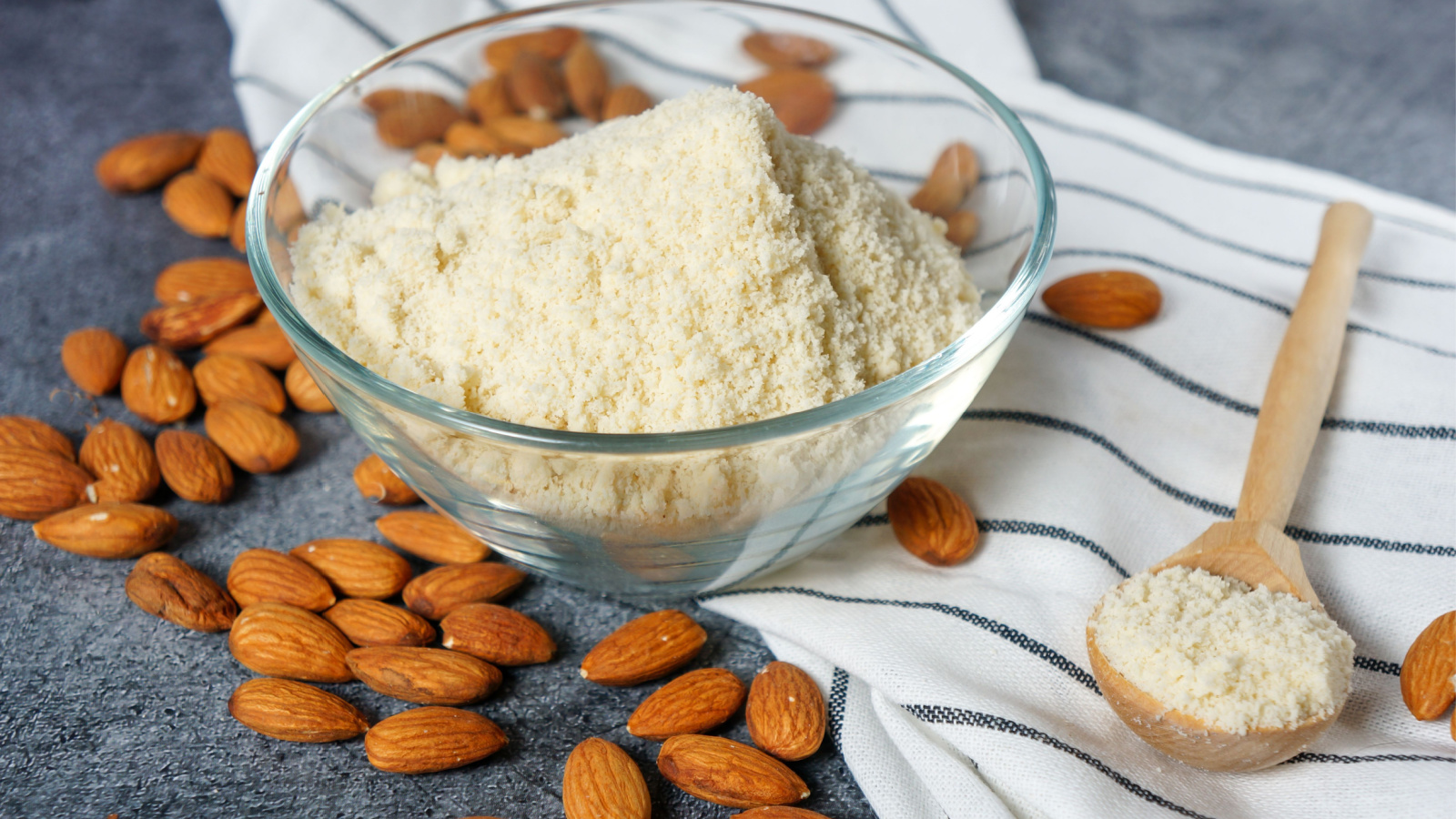Lupin Flour: A Comprehensive Guide to Help You Understand What it Is and Who Should Use It
Curious about using lupin flour in your low-carb recipes? This comprehensive guide will answer all your questions and then some.
What is Lupin Flour?
 Pin
PinLupin flour is a versatile, nutritious, and gluten-free alternative to wheat flour. It is made from the seeds of the lupin plant, also known as lupine, which is a member of the legume family. Lupin flour has been gaining popularity in recent years as a healthier alternative to wheat flour and a great addition to keto and gluten-free diets.
This article will explore the origins of lupin flour, its nutritional value, the diets it is good for, and some simple recipes that incorporate lupin flour. I’ll also touch on lupin beans and how they are traditionally consumed.
Lupin flour is a great ingredient to have in your pantry as it is high in protein and low in carbohydrates, which makes it a perfect ingredient for those who are looking to maintain a healthy, low-carb diet.
Lupin Flour Nutrition Facts
Lupin flour is a nutritious ingredient that is high in protein, low in carbohydrates, and rich in fiber.
One hundred grams of lupin flour contains around 40 grams of protein, which is higher than most other flour. It is also a good source of dietary fiber, containing around 25 grams per 100 grams of flour. Lupin flour is also a good source of minerals such as potassium, calcium, and iron.
It also contains a variety of vitamins, such as niacin and folate. The high protein and fiber content of lupin flour makes it a great option for those looking to add more protein and fiber to their diet.
It is also low in fat and calories, which makes it a great ingredient for weight loss and weight management. The low carbohydrate content also makes it a perfect ingredient for low-carb and ketogenic diets.
Lupin flour is also gluten-free, making it a great alternative for those with gluten sensitivities or celiac disease. Overall, lupin flour is a nutritious and healthy ingredient that can be used in a variety of recipes to boost the nutritional value and add a unique, nutty flavor.
Essential Amino Acids
One of the key nutritional benefits of lupin flour and lupin beans is their high content of essential amino acids. Amino acids are the building blocks of proteins and are essential for the growth and repair of our body’s cells. Lupin flour and beans are rich in a variety of essential amino acids, including lysine, methionine, and tryptophan.
Lysine is an essential amino acid that is important for collagen production, which is essential for healthy skin, hair, and nails. Lupin flour and beans are a rich source of lysine, which makes them a great addition to a vegetarian or vegan diet, as lysine is typically found in animal products.
Methionine is another essential amino acid that is found in lupin flour and beans. It is important for the metabolism of sulfur-containing compounds and for the formation of enzymes and other proteins. Methionine also helps to detoxify the liver and is important for healthy hair and nails.
Tryptophan is another essential amino acid found in lupin flour and beans, which is important for the production of serotonin, a neurotransmitter that plays a role in regulating mood, sleep, and appetite. It also helps in the production of niacin (vitamin B3), which is important for maintaining healthy skin and nerves.
In addition to these essential amino acids, lupin flour and beans also contain other important amino acids, making them a great source of complete protein. Lupin flour and beans are also gluten-free, which makes them a great option for those with gluten sensitivities or celiac disease. This makes them a valuable addition to any diet, especially for vegetarians and vegans who may lack essential amino acids in their diets.
Lupin Beans
 Pin
PinLupin beans, also known as lupini beans, are the yellow, slightly bitter seeds of the lupin plant. They have been used for centuries as a food source in various cultures.
Lupin beans are typically soaked and then boiled to remove the bitter taste before being consumed. They can be eaten as a snack or added to salads, sandwiches, and other dishes for a protein boost.
Lupin beans are traditionally eaten as a snack, particularly in the Mediterranean and South American cultures. They are often served in brine and are a popular treat in bars and pubs.
They are usually consumed as an appetizer or as a snack with a glass of wine or beer. In Italy, for example, lupin beans are often served in bars and pubs as a traditional snack, and in Spain, it is common to find them sold by street vendors.
They can also be used to make dips and spreads, such as the popular Mediterranean dish, “tahini-like” lupin paste. They can also be added to salads, sandwiches, and other dishes for a protein boost.
They are also consumed in South American countries such as Argentina and Brazil. Lupin beans are becoming increasingly popular in other regions as well, as their nutritional benefits are being recognized.
In addition to being a traditional food, Lupin beans are also grown for their seeds, which are used to make lupin flour.
Diets Lupin Flour is Good For
 Pin
PinLupin flour is a versatile ingredient that is suitable for a variety of diets. Its high protein and fiber content, as well as its low carbohydrate content, make it a great addition to gluten-free, low-carb, and weight-loss diets.
Gluten-free Diets
For those following a gluten-free diet, lupin flour is a great alternative to wheat flour. It is naturally gluten-free, making it safe for individuals with celiac disease or gluten sensitivities. Lupin flour can be used to make a variety of gluten-free bread, pasta, and other baked goods.
Low-carb Diets
Lupin flour is also a great option for those following a low-carb diet. It is low in carbohydrates and high in protein and fiber, making it a perfect ingredient for low-carb and ketogenic diets. It can be used to make low-carb bread, lupin flour pancakes, pizza crust, and other baked goods.
Vegetarian and Vegan Diets
Lupin flour is also a great option for vegetarians and vegans. Its high protein content makes it a great meat replacement in dishes such as veggie burgers, meatless meatballs, and other plant-based meals.
Weight-loss Diets
Lupin flour is also a great ingredient for weight loss and weight management. It is low in fat and calories and high in protein and fiber, making it a great ingredient to keep you feeling full and satisfied. It can be used in a variety of recipes, such as pancakes, waffles, and keto grits, to add protein and fiber without adding extra calories.
Overall, lupin flour is a versatile and nutritious ingredient that can be used in a variety of diets to boost the nutritional value and add a unique, nutty flavor.
Lupin Flour vs. Almond Flour
 Pin
PinLupin flour and almond flour are both gluten-free alternative flours, but they have different nutritional profiles and uses.
Lupin flour is made from the seeds of the lupin plant, which is a legume. It is high in protein, with around 40 grams per 100 grams of flour. It is also low in carbohydrates, making it a great option for low-carb and ketogenic diets. Lupin flour is also rich in fiber and contains a variety of vitamins and minerals, including potassium, calcium, and iron. Its protein content makes it a great option for vegetarians and vegans as a meat replacement.
Almond flour, on the other hand, is made from ground almonds. It is high in healthy fats, particularly monounsaturated fats, and is a good source of vitamin E. Almond flour is also high in protein but not as high as Lupin flour, containing around 14 grams per 100 grams of flour. Almond flour has a slightly sweet, nutty taste, which makes it suitable for baked goods and desserts. It is also low in carbohydrates but higher than Lupin flour.
Is lupin flour better than almond flour? It depends on what you need in your diet right now.
Lupin flour and almond flour are both gluten-free alternative flours, but they have different nutritional profiles and uses. Lupin flour is a great option for those following a gluten-free, low-carb, or high-protein diet, while almond flour is a great option for those looking to add healthy fats and a nutty flavor to their cooking.
I like to use lupin flour for its protein content without adding too much fat to my diet. Too much fat can cause a keto weight loss stall.
In summary, Lupin flour is a great option for those following a gluten-free, low-carb, or high-protein diet, while almond flour is a great option for those looking to add healthy fats and a nutty flavor to their cooking.
Both are gluten-free alternatives to wheat flour but have different nutritional values and, therefore, can be used in different ways. Lupin flour can be used as a meat replacement in addition to being used for baking and desserts.
Lupin Flour Allergy
Lupin flour is considered safe for most people to consume, however, some individuals may have an allergy or sensitivity to lupin flour. Lupin is a member of the legume family, and like other legumes, such as peanuts and soy, lupin may cause an allergic reaction in some people. People who are allergic to other legumes may also be allergic to lupin.
Symptoms of a lupin allergy can include itching, hives, swelling, difficulty breathing, and anaphylaxis (a severe, life-threatening allergic reaction). These symptoms can occur immediately after consuming lupin or up to several hours later.
It is also important to note that some people who are sensitive to gluten may also have a cross-reaction to lupin flour, as it contains similar proteins to gluten. If you have gluten sensitivity or celiac disease, it’s important to talk to your doctor or a dietitian before consuming lupin flour.
As a precaution, people with a known allergy to legumes or gluten should avoid lupin flour and lupin beans. If you suspect you have a lupin allergy, it is best to speak with an allergist for proper diagnosis and treatment.
Where to Buy Lupin Flour
Lupin flour can be found in some health food stores and specialty stores. However, it may not be as widely available as other gluten-free flours. Some popular options for buying lupin flour include:
- Online: Lupin flour can be purchased online through various retailers such as Amazon, iHerb, and Vitacost. This is a good option if you can’t find it in stores near you.
- Health food stores: Some health food stores carry lupin flour and other gluten-free flour. It’s worth checking with your local health food store to see if they carry it.
- Specialty stores: Some specialty stores that cater to gluten-free or health-conscious customers may carry lupin flour.
- Online Health food stores: You can also purchase Lupin flour from online health food stores. They will have a wide range of options, and you can select the one that suits you.
- Make it yourself: Lupin flour can also be made at home by grinding lupin beans in a food processor or grinder.
It’s worth noting that availability may vary depending on location, and prices may be higher than other gluten-free flour. However, as it becomes more popular, it is expected that it will become more widely available.
Lupin Flour Recipes to Try
You can find a variety of lupin flour recipes on this site. Start with the lupin flour brownies! You’ll love them!






